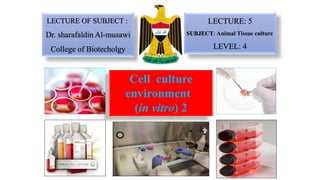
5 cell culture environment 2 lecture 5
- 1. Cell culture environment (in vitro) 2 LECTURE OF SUBJECT : Dr. sharafaldin Al-musawi College of Biotecholgy LECTURE: 5 SUBJECT: Animal Tissue culture LEVEL: 4
- 2. Cell Culture Environment Physico-chemical environment • Growth media (pH, osmotic pressure, O2 and CO2 tension) • Temperature Physiological environment • Hormone and nutrient concentrations
- 3. The culture medium is the most important component of the culture environment, because it provides: Necessary nutrients Growth factors Hormones for cell growth Regulating the pH of the culture Osmotic pressure of the culture Cell Culture Media
- 4. The three basic classes of media are: a. Basal media b. Reduced-serum media c. Serum-free media Cell Culture Media
- 5. Basal Media • Contains amino acids, vitamins, inorganic salts, and a carbon source such as glucose. • Basal media formulations must be further supplemented with serum. Cell Culture Media
- 6. Reduced-Serum Media • Basal media formulations enriched with nutrients and animal- derived factors with reduced amount of serum Cell Culture Media
- 7. Serum-Free Media • Appropriate nutritional and hormonal formulations replaces serum completely • Serum-free medium in combination with growth factors has the ability to make the selective medium for primary cell culture. Cell Culture Media
- 8. • Commonly used Medium: GMEM, EMEM,DMEM, RPMI etc. • Media is supplemented with Antibiotics (penicillin, streptomycin) BSA Na-bicarbonate L-glutamate Na-pyruvate HEPES Growth factors etc. Cell Culture Media
- 9. a) Serum: • Vitally important source of growth factors, adhesion factors, hormones, lipids and minerals • Regulates cell membrane permeability: • Serves as a carrier for lipids, enzymes, micronutrients, and trace elements into the cell. Factors affecting culture environment
- 10. b) pH Level: Cell line Optimal pH Mammalian cell lines 7.4 Transformed cell lines 7.0 – 7.4 Normal fibroblast cell lines 7.4 – 7.7 Insect cell lines 6.2 Factors affecting culture environment
- 11. • The growth medium controls the pH of the culture and buffers the cells in culture against changes in the pH. • Buffering is achieved by an organic (e.g., HEPES) or CO2-bicarbonate based buffer • 4 – 10% CO2 is common for most cell culture experiments c) CO2 Level Factors affecting culture environment
- 12. • The optimal temperature for cell culture largely depends on the body temperature of the host from which the cells were isolated. d) Temperature Cell line Optimal Temperature Human and mammals 36°C - 37° Insect cells 27°C Avian cell lines 38.5°C Cold-blooded animals (e.g., amphibians, cold-water fish) 15°C - 26°C Factors affecting culture environment
Editor's Notes
- One of the major advantages of cell culture is the ability to manipulate the physico-chemical (i.e., temperature, pH, osmotic pressure, O2 and CO2 tension) and the physiological environment (i.e., hormone and nutrient concentrations) in which the cells propagate. With the exception of temperature, the culture environment is controlled by the growth media. While the physiological environment of the culture is not as well defined as its physico-chemical environment, a better understanding of the components of serum, the identification of the growth factors necessary for proliferation, and a better appreciation of the microenvironment of cells in culture (i.e., cell-cell interactions, diffusion of gases, interactions with the matrix) now allow the culture of certain cell lines in serum-free media.
- Basal Media The majority of cell lines grow well in basal media, which contain amino acids, vitamins, inorganic salts, and a carbon source such as glucose, but these basal media formulations must be further supplemented with serum. Reduced-Serum Media Another strategy to reduce the undesired effects of serum in cell culture experiments is to use reduced-serum media. Reduced-serum media are basal media formulations enriched with nutrients and animal-derived factors, which reduce the amount of serum that is needed. Serum-Free Media Serum-free media (SFM) circumvents issues with using animal sera by replacing the serum with appropriate nutritional and hormonal formulations. Serum-free media formulations exist for many primary cultures and cell lines, including recombinant protein producing lines of Chinese Hamster Ovary (CHO), various hybridoma cell lines, the insect lines Sf9 and Sf21 (Spodoptera frugiperda), and for cell lines that act as hosts for viral production (e.g., 293, VERO, MDCK, MDBK), and others. One of the major advantages of using serum-free media is the ability to make the medium selective for specific cell types by choosing the appropriate combination of growth factors. The table below lists the advantages and disadvantages of serum-free media.
- Choice of media depends on the type of cell being cultured
- However, using serum in media has a number of disadvantages including high cost, problems with standardization, specificity, variability, and unwanted effects such as stimulation or inhibition of growth and/or cellular function on certain cell cultures
- The optimal temperature for cell culture largely depends on the body temperature of the host from which the cells were isolated, and to a lesser degree on the anatomical variation in temperature (e.g., temperature of the skin may be lower than the temperature of skeletal muscle). Overheating is a more serious problem than underheating for cell cultures; therefore, often the temperature in the incubator is set slightly lower than the optimal temperature. Optimal Temperatures for Various Cell Lines Most human and mammalian cell lines are maintained at 36°C to 37°C for optimal growth. Insect cells are cultured at 27°C for optimal growth; they grow more slowly at lower temperatures and at temperatures between 27°C and 30°C. Above 30°C, the viability of insect cells decreases, and the cells do not recover even after they are returned to 27°C. Avian cell lines require 38.5°C for maximum growth. Although these cells can also be maintained at 37°C, they will grow more slowly. Cell lines derived from cold-blooded animals (e.g., amphibians, cold-water fish) tolerate a wide temperature range between 15°C and 26°C.
